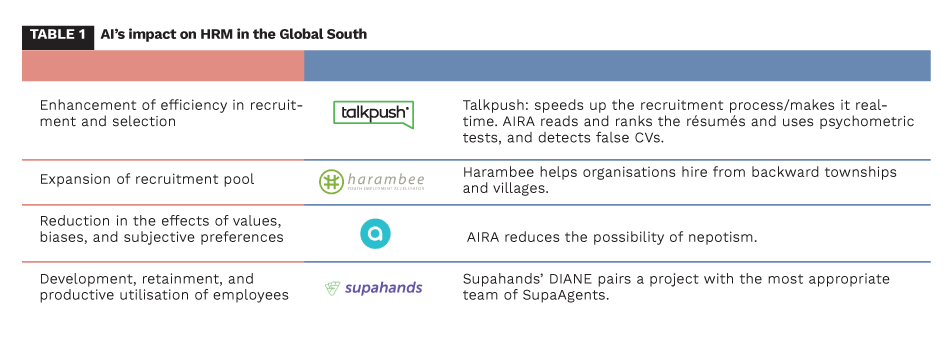By Nir Kshetri
Artificial intelligence is transforming human resource management (HRM) in the Global South. With AI, organisations in the Global South are enhancing efficiency in recruitment and selection, gaining access to a larger recruitment pool, and improving the retainment and productive utilisation of employees. Subjective criteria such as nepotism and favouritism are less likely to come into play in recruitment and selection.
Artificial intelligence (AI) is being touted as an effective human resource management (HRM) tool. AI deployments in HRM issues such as recruitment and selection are becoming increasingly widespread and have drastically reduced the time and cost of performing these functions. AI’s potential usefulness as a tool to improve and transform HRM strategy and performance is being increasingly recognised not only in developed countries, but also in the Global South.
While many AI-based tools used in HRM in the Global South have been developed in Global North countries, it is encouraging to note that a number of high-profile, Global South-based HRM companies with AI capabilities have emerged. For instance, the Chilean company Artificial Intelligence Recruitment Assistant (AIRA), which was identified by Forbes as among the ten most customer-focused companies in South America, publishes vacancy announcements in recruitment websites. It reads and ranks the résumés and uses psychometric tests1. It also conducts video interviews with applicants. Factors such as attention levels and facial expressions are converted into numbers. After all these processes are completed, human recruiters conduct in-depth interviews with the highest-ranked candidates.
Likewise, Nigeria-based SeamlessHR, which provides cloud-based human resources (HR) and payroll software, has recently raised $10 million in Series A funding for regional expansion. The company plans to use the fund to provide additional functionalities using artificial intelligence, data analytics, and machine learning2.
These developments are likely to further accelerate the use of AI in HRM in the Global South. Based on my recent research on the use of AI in the Global South economies3, I see four benefits that AI offers to HRM in these economies (table 1).
Enhancement of efficiency in recruitment and selection
AI tools are efficient in terms of cost. According to Glassdoor, on average, an employer spends about US$3,900 to hire a new worker and the process takes 27.5 days4. With AI deployment in HRM, organisations can reduce recruiting costs. For instance, the recruitment platform Talkpush5, which operates in Global South economies such as the Philippines, India, Mexico, and Costa Rica6, charges a minimum of US$300 per month, which allows 100 interviews (US$3 per interview). High-volume packages reduce the cost per interview to US$0.50. AI deployment can thus address the cost‐efficiency challenges observed in the Global South economies.
AI tools are also efficient in terms of defect reduction. A key benefit of AI tools is to detect fraudulent activities by candidates. For instance, the AIRA system can effectively detect a false CV7.
Expansion of recruitment pool
In many Global South economies, there is a surplus of unskilled labour but, at the same time, a significant shortage of highly skilled human capital. A related problem is the lack of information on human resources. AI tools can tackle these problems. One example is the South African social enterprise Harambee’s AI tool to help young people find jobs. Harambee uses Google’s open-source AI TensorFlow to interact with more than 1 million young people. It uses precise geographical attributes and preferential behavioural metrics to achieve its goals. Harambee uses machine learning (ML) to more effectively use the data it has collected. Harambee’s data-driven approach has helped South African youth find over 240,000 job opportunities8.
Harambee’s young recruiters, referred to as “feet on the streets”, visit backward townships and villages to collect contacts of unemployed people. Some of these are invited into its offices to assess their interests and skills and test analytical capabilities. Harambee helps them create email accounts and CVs and facilitates the interview process. It provides advice and information on ways to prepare for the interviews, such as how to dress and the kinds of questions that might be asked. Potential candidates are also offered clothes for free for the interview. It also provides work readiness interventions, which address the risks that employers have identified9. Promising candidates can also get additional assessment and vocational trainings in call centres or similar facilities10.
Reduction in the effects of values, biases, and subjective preferences
HRM processes such as recruitment, selection, and promotion practices in many Global South countries are based on favouritism, nepotism, and political loyalty. For instance, while it is a legal requirement for listed Indian companies to appoint independent directors, a large proportion of such companies fail to comply, thanks to the culture of nepotism and favouritism. The new Companies Act of 2013 requires at least one-third of a listed company’s total number of directors on the board to be independent. About 17 per cent of S&P Bombay Stock Exchange (S&P BSE) 500 companies were reported to violate the regulation11.
AI-based HRM solutions attempt to address these problems. For instance, AIRA claims that its AI tools reduce the possibility of nepotism, which is a problem in the state and private sectors in Chile. In the mining sector, for instance, the recruiting process in Chile is biased towards men, due to “self‐discrimination” of workers, and male dominance12. Overall, the recruiter’s own values, biases, and subjective preferences have no place in AI-based recruitment. By replacing human beings with machines in key decision-making processes, the unfavourable effects of factors such as emotions, feelings, wants, and needs can be removed.

Development, retainment, and productive utilisation of employees
In most Global South economies, employee productivity-related criteria get less importance.
AI tools can help overcome such challenges. For instance, the Malaysian outsourcing company Supahands’ DIANE is a predictive routing system to match agents and projects based on timing and relevance13. The company has SupaAgents in the Philippines, Indonesia, and Malaysia14.
SupaAgents handle over 1 million units of data each month. The company collects and aggregates data about each SupaAgent. The collected data includes skills, availability, and past performance. DIANE utilises the information to pair a project with the most appropriate team of SupaAgents. Projects are broken down into small units – micro-tasks. The task is divided between humans and machines, so that multiple people can work on a project to improve speed, efficiency, and accuracy. They can also be aggregated into larger projects which require multiple workers. The goal is to ensure that SupaAgents complete the project at high levels of accuracy and that the right sets of skills are assigned to each project.
Concluding comments
AI is playing an increasingly important role in HRM in the Global South. AI-based HRM tools are efficient in terms of a number of objectives, such as reducing the time to hire a candidate, costs, and utilization of other resources. The number and variety of metrics used in recruitment can be increased through using AI. AI is likely to emerge as an important force for achieving HRM goals such as attracting top talents, improving their retention, and developing leadership capabilities.
AI-based HRM tools have a higher value addition in the Global South economies, due to formal factors (e.g., a high level of corruption and the underdeveloped rule of law), informal factors (e.g., the prevalence of nepotism), and economic factors (e.g., inadequate record-keeping practices) in these economies. The conditions promoting supervisor behaviours that demoralise employees can facilitate other forms of abuse. AI will also be an effective tool to fight against acts of corruption such as nepotism, cronyism, and favouritism.
About the Author
 Nir Kshetri is a Professor at University of North Carolina-Greensboro. He has authored twelve books and about 200 academic articles. He is a two-time TEDx speaker about the roles of emerging technologies, such as artificial intelligence (https://www.youtube.com/watch?v=W6da0kEfBsY&t=590s ) and blockchain, in fighting poverty (https://www.youtube.com/watch?v=WDo_Jlov9R4). Nir has travelled to more than 100 countries.
Nir Kshetri is a Professor at University of North Carolina-Greensboro. He has authored twelve books and about 200 academic articles. He is a two-time TEDx speaker about the roles of emerging technologies, such as artificial intelligence (https://www.youtube.com/watch?v=W6da0kEfBsY&t=590s ) and blockchain, in fighting poverty (https://www.youtube.com/watch?v=WDo_Jlov9R4). Nir has travelled to more than 100 countries.
References
- https://www.forbes.com/sites/blakemorgan/2018/12/18/the-10-most-customer-focused-companies-in-south-america/?sh=71abcf02201e
- https://techcrunch.com/2022/01/12/nigerias-seamlesshr-raises-10m-to-expand-hr-and-payroll-solutions-across-africa/
- (https://www.press.umich.edu//12205632) in HRM (https://www.emerald.com/insight/content/doi/10.1108/MRR-03-2020-0168/full/html) and other areas (https://www.youtube.com/watch?v=W6da0kEfBsY), such as financial inclusion (https://www.tandfonline.com/doi/full/10.1080/1097198X.2021.1871273 )
- https://www.glassdoor.co.uk/employers/blog/calculate-cost-per-hire/
- https://www.getonbrd.com/jobs/digital-marketing/head-of-marketing-talkpush-remote
- https://talkpush.com/
- https://www.emerald.com/insight/content/doi/10.1108/MRR-03-2020-0168/full/html
- https://www.computer.org/csdl/magazine/co/2022/04/09755238/1CubvLQZQPu
- https://www.usaid.gov/sites/default/files/documents/15396/AI-ML-in-Development.pdf
- https://www.computer.org/csdl/magazine/co/2022/04/09755238/1CubvLQZQPu
- https://qz.com/india/565025/putting-family-first-indias-corporate-boards-flout-mandate-on-independent-directors/
- https://www.emerald.com/insight/content/doi/10.1108/ARLA-11-2013-0184/full/html
- https://www.forbes.com/sites/jonathanmoed/2018/06/28/joining-human-artificial-intelligence-in-malaysia-to-build-the-worlds-most-efficient-workforce/#271ad5775b70
- https://www.entrepreneur.com/article/335031







![Deconstructing the Myth of Entrepreneurship iStock-2151090098 [Converted]](https://www.europeanbusinessreview.com/wp-content/uploads/2024/09/iStock-2151090098-Converted-218x150.png)





























